Global Automotive Rain Sensor Market Forecast
- The market for automotive rain sensors worth US$4.5 Bn in 2022 poised to reach US$7.5 Bn by 2030
- Market size likely to see a CAGR of 7.6% between 2023 and 2030
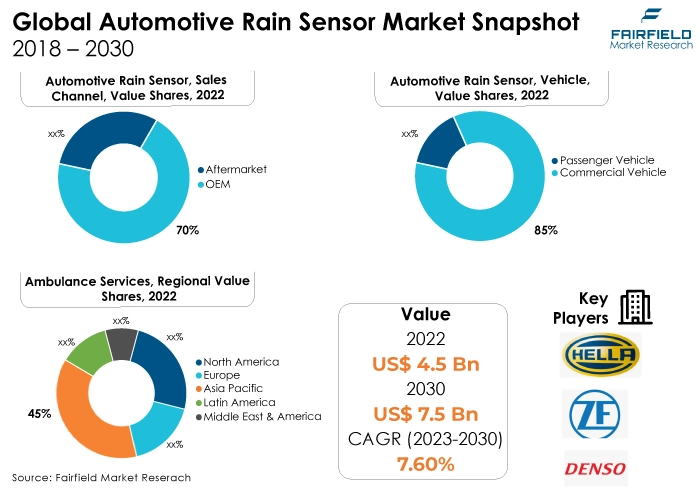
Quick Report Digest
- The key trend anticipated to fuel the automotive rain sensor market growth is stringent safety regulations, and the increasing focus on driver and passenger safety has driven the demand for advanced automotive technologies, including rain sensors, enhancing driving visibility during adverse weather conditions.
- Continuous technological advancements, such as the incorporation of AI and machine learning algorithms, improve the precision and effectiveness of rain sensors, creating new opportunities for innovation and market expansion.
- In 2022, rising urbanisation rates and an increasing preference for premium vehicles with advanced features contributed to the growing adoption of rain sensors, especially in passenger vehicles, presenting market opportunities.
- OEMs dominate the market due to their direct integration of rain sensor technologies during vehicle manufacturing, ensuring standardised and high-quality installations across a wide range of vehicles.
- In 2022, the aftermarket segment is witnessing rapid growth as consumers seek to retrofit older vehicles with advanced rain sensor technologies, creating a niche market driven by consumer demand and convenience.
- Rain sensors find extensive usage in passenger vehicles, where driver and passenger safety and comfort are paramount, making it the dominant segment in the market.
- Due to the presence of major automakers in nations like China, Japan, and South Korea, the Asia Pacific region dominates the market for automotive rain sensors. The region's robust manufacturing capabilities, coupled with the increasing demand for vehicles, solidify its dominance in the market.
- North America is the fastest-growing region in the market, primarily driven by the growing awareness of advanced vehicle safety technologies and the increasing adoption of premium vehicles equipped with rain sensors.
A Look Back and a Look Forward - Comparative Analysis
The automotive rain sensor market is witnessing robust growth driven by increasing safety concerns and the demand for advanced vehicle features. Rain sensors, designed to automatically activate windshield wipers upon detecting rain or moisture, have become a vital component in modern vehicles. Stringent safety regulations, coupled with rising consumer awareness about road safety, have led to widespread adoption. OEMs, and aftermarket sales channels are actively incorporating these sensors into passenger vehicles and commercial vehicles, enhancing driving visibility and safety during adverse weather conditions.
The market witnessed staggered growth during the historical period 2018 – 2022. The automotive Rain Sensor Market experienced significant growth. Technological innovations, such as the integration of artificial intelligence and improved sensor sensitivity, marked this period. Both OEMs and aftermarket segments witnessed a surge in demand. Passenger vehicles, especially in the mid-to-high-end segments, were equipped with rain sensors as a standard feature. The market saw an expansion of product offerings and competitive pricing, making rain sensors more accessible to a broader consumer base.
The automotive rain sensor market appears promising. Anticipated technological advancements, including the implementation of advanced machine learning algorithms and the integration of rain sensors into connected and autonomous vehicles, are expected to drive market growth. The aftermarket segment is projected to expand as consumers seek to retrofit older vehicles with these advanced technologies. Moreover, stringent safety regulations and the growing demand for electric vehicles will further fuel the market. Asia Pacific is set to remain a dominant market, with North America, and Europe witnessing accelerated growth.
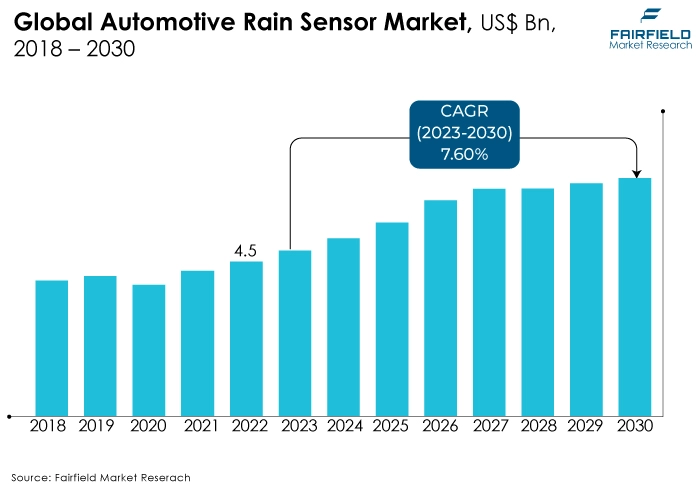
Key Growth Determinants
- Rapid Technological Advancements
Technological innovations in the automotive rain sensor market serve as a major growth driver. Advancements such as the integration of AI algorithms, machine learning, and IoT capabilities have significantly improved the accuracy and responsiveness of rain sensors. These innovations enable real-time detection of varying levels of rainfall and automatically adjust wiper speed, ensuring optimal visibility for drivers.
Additionally, the integration of rain sensors with connected vehicle systems enhances overall vehicle safety. As automotive manufacturers strive to offer more advanced and efficient rain-sensing solutions, the market experiences a surge in demand, especially from premium and luxury vehicle segments.
- Regulatory Emphasis on Vehicle Safety
Stringent safety regulations imposed by governments and regulatory bodies worldwide contribute significantly to the growth of the automotive rain sensor market. Authorities are increasingly mandating the incorporation of safety features in vehicles to reduce accidents caused by impaired visibility during adverse weather conditions.
Rain sensors, by enhancing visibility and enabling timely activation of wipers, align with these safety requirements. Automakers are thus compelled to install rain sensor systems in their vehicles to meet these regulations. This regulatory push not only fuels market demand but also ensures a consistent market presence for rain sensor technologies.
- Growing Consumer Awareness About Comfort and Safety Features
Rain sensors are becoming more and more common in cars due to consumer desire for improved comfort and safety features. Contemporary buyers, especially those who live in cities, are looking for cars with cutting-edge features that enhance their driving experience. The ease of automatic wiper activation is provided by rain sensors, which remove the need for manual adjustments and guarantee clean view without requiring driver participation.
As buyers increasingly prioritise such conveniences, automakers are integrating rain sensors into their models across various price points. This consumer-driven demand propels market growth, encouraging manufacturers to innovate and offer more sophisticated rain-sensing solutions to meet evolving customer expectations.
Major Growth Barriers
- Cost Constraints, and Affordability Issues
The automotive rain sensor market is the cost factor. Advanced rain sensor technologies involve intricate engineering and sophisticated components, making them relatively expensive. As a result, their integration in budget or mid-range vehicles becomes financially challenging for both manufacturers and consumers. Affordability concerns often limit widespread adoption, hindering market expansion, especially in price-sensitive markets.
- Reliability and Maintenance Challenges
Reliability issues and the need for frequent maintenance pose another restraint. Rain sensors, being electronic devices, are susceptible to wear, dust, and moisture, affecting their accuracy over time. Calibration and regular maintenance are essential, yet consumers might overlook these aspects.
Malfunctioning sensors can lead to ineffective wiper operations, compromising driver visibility during rain, which raises concerns about vehicle safety. Ensuring consistent reliability and educating consumers about proper maintenance practices are critical challenges faced by manufacturers in the rain sensor market.
Key Trends and Opportunities to Look at
- Integration of AI and IoT
The trend towards integrating Artificial Intelligence (AI), and Internet of Things (IoT) technologies in rain sensors is growing. This integration enhances real-time data analysis, allowing predictive maintenance and customised functionality. Popular in North America, and Europe, companies like Bosch, and Valeo lead in implementing AI-driven rain-sensing solutions, setting a precedent for global adoption.
- Smart Windshield Technology
Smart windshields, capable of displaying real-time weather information and enhancing driving visibility, are gaining traction. This trend, prominent in Asia Pacific, particularly in countries like Japan, and South Korea, is seeing innovations from companies like Denso, and Continental. Brands are leveraging these smart windshields to offer a seamless driving experience, enhancing safety and convenience for consumers.
- Environmentally Sustainable Sensors
Environmentally sustainable rain sensor technologies are becoming a priority. Companies are developing sensors using eco-friendly materials and energy-efficient processes. This trend is gaining popularity across regions, especially in Europe, where environmental consciousness is high. Key players like Hella, and TRW Automotive are investing in green technologies, aligning with global environmental initiatives. Brands are leveraging these sustainable solutions for eco-conscious consumers, enhancing their market presence and corporate responsibility.
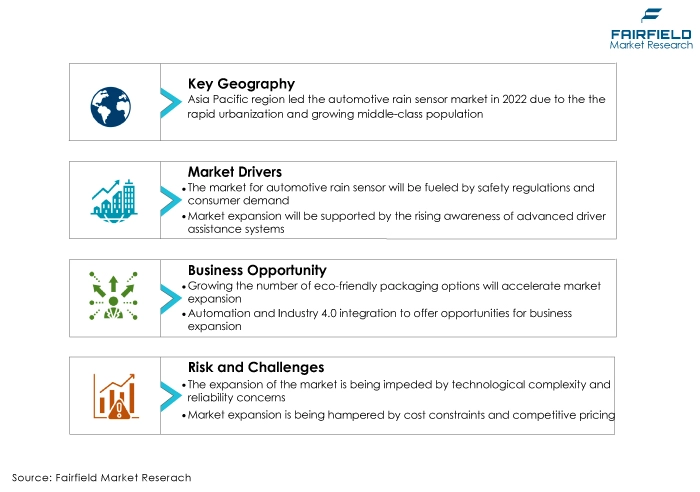
How Does the Regulatory Scenario Shape this Industry?
The automotive rain sensor market is significantly shaped by stringent regulatory frameworks that emphasize vehicle safety and environmental standards. Regulatory bodies such as the National Highway Traffic Safety Administration (NHTSA) in the US, and the European Union’s Vehicle Regulations (ECE R43) mandate the inclusion of safety features, including rain sensors, in vehicles to enhance driver visibility during adverse weather conditions. These regulations dictate the minimum standards and testing procedures that rain sensors must meet ensuring their effectiveness and reliability.
Moreover, there is a global push towards reducing vehicle emissions. Regulations like the Euro 6 emission standards in Europe, and Corporate Average Fuel Economy (CAFE) standards in the US encourage the use of rain sensors to optimise windshield wiper operation. By automatically adjusting wiper speed based on real-time weather conditions, rain sensors contribute to energy efficiency and reduced fuel consumption. Region-specific changes, such as the implementation of Bharat Stage VI (BS-VI) emission standards in India, are also influencing rain sensor adoption.
Fairfield’s Ranking Board
Top Segments
- OEM Category Continues to Dominate over Top Load Segments
The OEM segment stands as the dominant sales channel in 2022. OEMs, which integrate rain sensors directly during vehicle manufacturing, hold a significant market share, accounting for approximately 70% of the total market. This dominance is due to the widespread adoption of rain sensors as a standard feature in new vehicles, driven by stringent safety regulations and consumers' increasing demand for advanced safety technologies.
Furthermore, the Aftermarket segment represents the fastest-growing category in the Automotive Rain Sensor Market, with a notable annual growth rate of approximately 8-10%. This growth is due to the rising trend of consumers retrofitting older vehicles with advanced safety features.
- The Passenger Vehicles Segment Holds the Lion’s Share
In 2022, the passenger vehicle category emerged as the dominant segment, accounting for approximately 85% of the market share. Passenger vehicles, including sedans, SUVs, and hatchbacks, are equipped with rain sensors as a standard or optional feature by many manufacturers. Safety concerns and the desire for enhanced driving comfort primarily drive this high adoption rate.
The commercial vehicle category represents the fastest-growing market segment, experiencing an annual growth rate of approximately 12-15%. Commercial vehicles, including trucks, buses, and vans, are increasingly integrating rain sensors to enhance safety and comply with stringent regulations. The growth in e-commerce and logistics industries has led to an increased demand for commercial vehicles, driving the adoption of rain sensors in this segment.
Regional Frontrunners
Asia Pacific Reigns Supreme in Global Market
Asia Pacific continues to be the largest revenue-contributing region in the Global automotive rain sensor market, holding a significant market share of approximately 45%. Several factors contribute to this dominance. The region's robust automotive industry, particularly in countries like China, Japan, and South Korea fuels the demand for rain sensors in both passenger and commercial vehicles.
The increasing awareness of road safety and the implementation of stringent regulations by governing bodies in countries like India, and China have driven the adoption of rain sensors as a standard safety feature. Additionally, the growing middle-class population's preference for vehicles with advanced safety technologies, including rain sensors, further boosts the market in Asia Pacific.
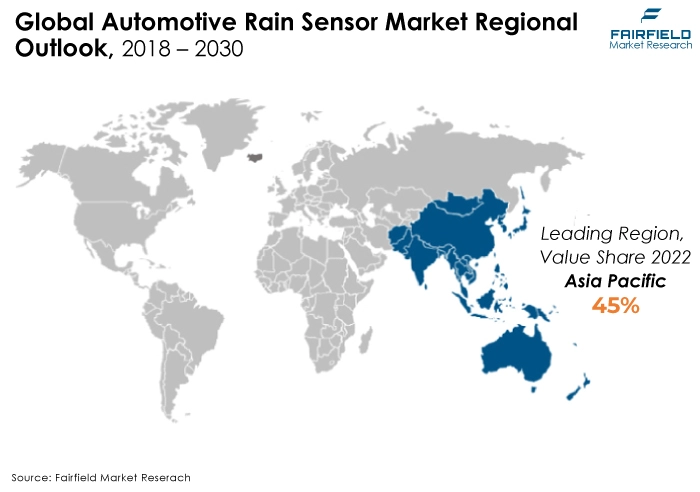
North America’s Prospects Upbeat with Favourable Safety Regulations
North America is poised to witness significant growth in sales in the automotive rain sensor market during the forecast period, with a estimated market share of around 30%. Several factors contribute to this growth. Stringent safety regulations imposed by organisations like the National Highway Traffic Safety Administration (NHTSA) in the US mandate the incorporation of rain sensors in vehicles to enhance road safety, driving the market demand.
The region's high consumer awareness about advanced automotive technologies and the willingness to pay for safety features contribute to the increased adoption of rain sensors. Additionally, the presence of prominent automobile manufacturers focusing on integrating advanced safety systems, including rain sensors, in their vehicles further propels the market.
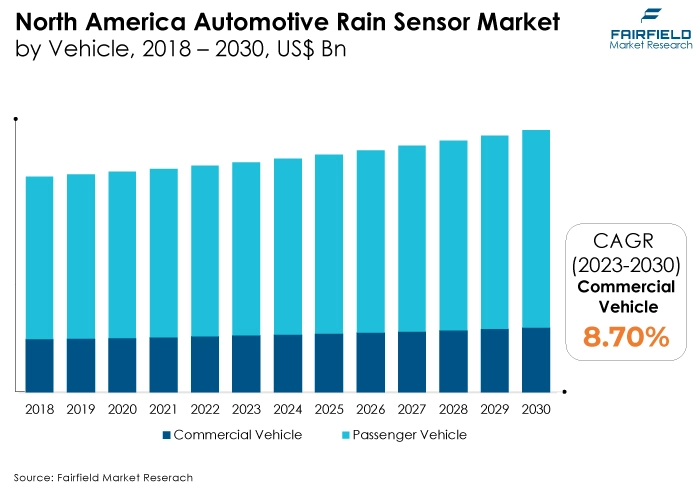
Fairfield’s Competitive Landscape Analysis
In the competitive landscape, differentiation will be key. Companies that invest in research and development to create cutting-edge sensors that are adaptive to various weather conditions will dominate. Collaborations between automakers and sensor manufacturers will yield innovative solutions. Pricing strategies will become dynamic, reflecting not only production costs but also technological advancements. Fierce competition will also drive mergers and acquisitions, consolidating the market.
Who are the Leaders in the Global Automotive Rain Sensor Space?
- DENSO CORPORATION.
- HELLA GmbH & Co. KGaA
- ZF Friedrichshafen AG
- Robert Bosch GmbH
- Hamamatsu Photonics K.K.
- MITSUBISHI MOTORS CORPORATION.
- Vishay Intertechnology, Inc.
- Leopold Kostal GmbH & Co. KG
- Valeo
- Tesla
- Shanghai Baolong Automotive Corporation
- General Motors
- Pacific Industrial Co.Ltd
Significant Company Developments
New Product Launch
- December 2020: TThe first four-quadrant silicon PIN photodiode in the market was unveiled by Vishay Intertechnology's optoelectronic division in a conventional surface-mount package, suitable for automotive applications. combining great photosensitivity with minimal crosstalk of 0.1% and almost negligible segment tolerance. Numerous sensors and control applications for the automotive, industrial, and consumer markets were made possible by the Vishay Semiconductors K857PE.
- January 2021: In Japan, Valeo began testing level 4 autonomous driving technology. The company's self-driving system combines data from communication between vehicles and traffic lights with information from three-dimensional maps. In order to attain level 4 autonomy, the corporation is attempting to access the dependability and capability of its LiDAR sensors.
- June 2021:Lincoln, a division of Ford Motor Company, declared its intention to electrify every model in its line-up by 2030. Lincoln expects half of its worldwide vehicle volume to be zero-emission cars by 2025 thanks to the Ford+ strategy and Ford Motor Company's projected electrification investment of more than USD 30 billion.
Distribution Agreement
- March 2021: HELLA and Wejo, a supplier of automotive data, have partnered. With HELLA's vast sensor experience, Wejo should be able to find new applications for battery, high-performance radar, and rain-light-climate sensors.
- March 2022:F. and StradVision jointly established a cooperation to increase the selection of autonomous driving perception software. Environmental sensor fusion for shuttles, light and commercial automobiles designed for centralised electricity systems, and vehicles that can recognise and identify objects in inclement weather or low light might all be made possible with StradVision's SVNet software.
An Expert’s Eye
Demand and Future Growth
In the realm of market demand and future growth, the automotive industry's relentless pursuit of innovation and safety will be the driving force. The increasing focus on electric and autonomous vehicles will necessitate more sophisticated rain-sensing technologies.
As environmental concerns heighten, the demand for energy-efficient sensors made from sustainable materials will rise, indicating a shift toward eco-conscious manufacturing practices. Moreover, as emerging economies experience a rise in disposable income, consumer preferences for advanced safety features, including rain sensors, will amplify, creating a sustained demand.
Supply Side of the Market
According to our analysis, challenges might arise due to the intricate nature of rain sensor technology. Striking a balance between complexity and user-friendliness will be crucial. Supply chain resilience will be tested, especially considering the global nature of component acquisition. Companies that invest in local sourcing and resilient supply chains will be better positioned to navigate unforeseen disruptions.
A solid supply chain would also be ensured by improvements in manufacturing techniques like 3D printing and automation, which could optimise output while increasing efficiency and lowering prices. These developments may also make it possible for businesses to quickly respond to shifts in customer demand or market dynamics. Additionally, employing strong data analytics and predictive modeling can offer insightful data on the functioning of the supply chain, assisting businesses in proactively identifying potential bottlenecks or vulnerabilities.
Global Automotive Rain Sensor Market is Segmented as Below:
By Sales Channel:
- OEM
- Aftermarket
By Vehicle:
- Passenger Vehicle
- Commercial Vehicle
By Geographic Coverage:
- North America
- U.S.
- Canada
- Europe
- Germany
- U.K.
- France
- Italy
- Turkey
- Russia
- Rest of Europe
- Asia Pacific
- China
- Japan
- South Korea
- India
- Southeast Asia
- Rest of Asia Pacific
- Latin America
- Brazil
- Mexico
- Argentina
- Rest of Latin America
- Middle East & Africa
- GCC
- South Africa
- Egypt
- Nigeria
- Rest of the Middle East & Africa
1. Executive Summary
1.1. Global Automotive Rain Sensor Market Snapshot
1.2. Future Projections
1.3. Key Market Trends
1.4. Regional Snapshot, by Value, 2022
1.5. Analyst Recommendations
2. Market Overview
2.1. Market Definitions and Segmentations
2.2. Market Dynamics
2.2.1. Drivers
2.2.2. Restraints
2.2.3. Market Opportunities
2.3. Value Chain Analysis
2.4. Porter’s Five Forces Analysis
2.5. COVID-19 Impact Analysis
2.5.1. Supply
2.5.2. Demand
2.6. Impact of Ukraine-Russia Conflict
2.7. Economic Overview
2.7.1. World Economic Projections
2.8. PESTLE Analysis
3. Global Automotive Rain Sensor Market Outlook, 2018 - 2030
3.1. Global Automotive Rain Sensor Market Outlook, by Sales Channel, Value (US$ Bn), 2018 - 2030
3.1.1. Key Highlights
3.1.1.1. OEM
3.1.1.2. Aftermarket
3.2. Global Automotive Rain Sensor Market Outlook, by Vehicle, Value (US$ Bn), 2018 - 2030
3.2.1. Key Highlights
3.2.1.1. Passenger Vehicle
3.2.1.2. Commercial Vehicle
3.3. Global Automotive Rain Sensor Market Outlook, by Region, Value (US$ Bn), 2018 - 2030
3.3.1. Key Highlights
3.3.1.1. North America
3.3.1.2. Europe
3.3.1.3. Asia Pacific
3.3.1.4. Latin America
3.3.1.5. Middle East & Africa
4. North America Automotive Rain Sensor Market Outlook, 2018 - 2030
4.1. North America Automotive Rain Sensor Market Outlook, by Sales Channel, Value (US$ Bn), 2018 - 2030
4.1.1. Key Highlights
4.1.1.1. OEM
4.1.1.2. Aftermarket
4.2. North America Automotive Rain Sensor Market Outlook, by Vehicle, Value (US$ Bn), 2018 - 2030
4.2.1. Key Highlights
4.2.1.1. Passenger Vehicle
4.2.1.2. Commercial Vehicle
4.2.2. BPS Analysis/Market Attractiveness Analysis
4.3. North America Automotive Rain Sensor Market Outlook, by Country, Value (US$ Bn), 2018 - 2030
4.3.1. Key Highlights
4.3.1.1. U.S. Automotive Rain Sensor Market by Sales Channel, Value (US$ Bn), 2018 - 2030
4.3.1.2. U.S. Automotive Rain Sensor Market, by Vehicle, Value (US$ Bn), 2018 - 2030
4.3.1.3. Canada Automotive Rain Sensor Market by Sales Channel, Value (US$ Bn), 2018 - 2030
4.3.1.4. Canada Automotive Rain Sensor Market, by Vehicle, Value (US$ Bn), 2018 - 2030
4.3.2. BPS Analysis/Market Attractiveness Analysis
5. Europe Automotive Rain Sensor Market Outlook, 2018 - 2030
5.1. Europe Automotive Rain Sensor Market Outlook, by Sales Channel, Value (US$ Bn), 2018 - 2030
5.1.1. Key Highlights
5.1.1.1. OEM
5.1.1.2. Aftermarket
5.2. Europe Automotive Rain Sensor Market Outlook, by Vehicle, Value (US$ Bn), 2018 - 2030
5.2.1. Key Highlights
5.2.1.1. Passenger Vehicle
5.2.1.2. Commercial Vehicle
5.2.2. BPS Analysis/Market Attractiveness Analysis
5.3. Europe Automotive Rain Sensor Market Outlook, by Country, Value (US$ Bn), 2018 - 2030
5.3.1. Key Highlights
5.3.1.1. Germany Automotive Rain Sensor Market by Sales Channel, Value (US$ Bn), 2018 - 2030
5.3.1.2. Germany Automotive Rain Sensor Market, by Vehicle, Value (US$ Bn), 2018 - 2030
5.3.1.3. U.K. Automotive Rain Sensor Market by Sales Channel, Value (US$ Bn), 2018 - 2030
5.3.1.4. U.K. Automotive Rain Sensor Market, by Vehicle, Value (US$ Bn), 2018 - 2030
5.3.1.5. France Automotive Rain Sensor Market by Sales Channel, Value (US$ Bn), 2018 - 2030
5.3.1.6. France Automotive Rain Sensor Market, by Vehicle, Value (US$ Bn), 2018 - 2030
5.3.1.7. Italy Automotive Rain Sensor Market by Sales Channel, Value (US$ Bn), 2018 - 2030
5.3.1.8. Italy Automotive Rain Sensor Market, by Vehicle, Value (US$ Bn), 2018 - 2030
5.3.1.9. Turkey Automotive Rain Sensor Market by Sales Channel, Value (US$ Bn), 2018 - 2030
5.3.1.10. Turkey Automotive Rain Sensor Market, by Vehicle, Value (US$ Bn), 2018 - 2030
5.3.1.11. Russia Automotive Rain Sensor Market by Sales Channel, Value (US$ Bn), 2018 - 2030
5.3.1.12. Russia Automotive Rain Sensor Market, by Vehicle, Value (US$ Bn), 2018 - 2030
5.3.1.13. Rest of Europe Automotive Rain Sensor Market by Sales Channel, Value (US$ Bn), 2018 - 2030
5.3.1.14. Rest of Europe Automotive Rain Sensor Market, by Vehicle, Value (US$ Bn), 2018 - 2030
5.3.2. BPS Analysis/Market Attractiveness Analysis
6. Asia Pacific Automotive Rain Sensor Market Outlook, 2018 - 2030
6.1. Asia Pacific Automotive Rain Sensor Market Outlook, by Sales Channel, Value (US$ Bn), 2018 - 2030
6.1.1. Key Highlights
6.1.1.1. OEM
6.1.1.2. Aftermarket
6.2. Asia Pacific Automotive Rain Sensor Market Outlook, by Vehicle, Value (US$ Bn), 2018 - 2030
6.2.1. Key Highlights
6.2.1.1. Passenger Vehicle
6.2.1.2. Commercial Vehicle
6.2.2. BPS Analysis/Market Attractiveness Analysis
6.3. Asia Pacific Automotive Rain Sensor Market Outlook, by Country, Value (US$ Bn), 2018 - 2030
6.3.1. Key Highlights
6.3.1.1. China Automotive Rain Sensor Market by Sales Channel, Value (US$ Bn), 2018 - 2030
6.3.1.2. China Automotive Rain Sensor Market, by Vehicle, Value (US$ Bn), 2018 - 2030
6.3.1.3. Japan Automotive Rain Sensor Market by Sales Channel, Value (US$ Bn), 2018 - 2030
6.3.1.4. Japan Automotive Rain Sensor Market, by Vehicle, Value (US$ Bn), 2018 - 2030
6.3.1.5. South Korea Automotive Rain Sensor Market by Sales Channel, Value (US$ Bn), 2018 - 2030
6.3.1.6. South Korea Automotive Rain Sensor Market, by Vehicle, Value (US$ Bn), 2018 - 2030
6.3.1.7. India Automotive Rain Sensor Market by Sales Channel, Value (US$ Bn), 2018 - 2030
6.3.1.8. India Automotive Rain Sensor Market, by Vehicle, Value (US$ Bn), 2018 - 2030
6.3.1.9. Southeast Asia Automotive Rain Sensor Market by Sales Channel, Value (US$ Bn), 2018 - 2030
6.3.1.10. Southeast Asia Automotive Rain Sensor Market, by Vehicle, Value (US$ Bn), 2018 - 2030
6.3.1.11. Rest of Asia Pacific Automotive Rain Sensor Market by Sales Channel, Value (US$ Bn), 2018 - 2030
6.3.1.12. Rest of Asia Pacific Automotive Rain Sensor Market, by Vehicle, Value (US$ Bn), 2018 - 2030
6.3.2. BPS Analysis/Market Attractiveness Analysis
7. Latin America Automotive Rain Sensor Market Outlook, 2018 - 2030
7.1. Latin America Automotive Rain Sensor Market Outlook, by Sales Channel, Value (US$ Bn), 2018 - 2030
7.1.1. Key Highlights
7.1.1.1. OEM
7.1.1.2. Aftermarket
7.2. Latin America Automotive Rain Sensor Market Outlook, by Vehicle, Value (US$ Bn), 2018 - 2030
7.2.1. Key Highlights
7.2.1.1. Passenger Vehicle
7.2.1.2. Commercial Vehicle
7.2.2. BPS Analysis/Market Attractiveness Analysis
7.3. Latin America Automotive Rain Sensor Market Outlook, by Country, Value (US$ Bn), 2018 - 2030
7.3.1. Key Highlights
7.3.1.1. Brazil Automotive Rain Sensor Market by Sales Channel, Value (US$ Bn), 2018 - 2030
7.3.1.2. Brazil Automotive Rain Sensor Market, by Vehicle, Value (US$ Bn), 2018 - 2030
7.3.1.3. Mexico Automotive Rain Sensor Market by Sales Channel, Value (US$ Bn), 2018 - 2030
7.3.1.4. Mexico Automotive Rain Sensor Market, by Vehicle, Value (US$ Bn), 2018 - 2030
7.3.1.5. Argentina Automotive Rain Sensor Market by Sales Channel, Value (US$ Bn), 2018 - 2030
7.3.1.6. Argentina Automotive Rain Sensor Market, by Vehicle, Value (US$ Bn), 2018 - 2030
7.3.1.7. Rest of Latin America Automotive Rain Sensor Market by Sales Channel, Value (US$ Bn), 2018 - 2030
7.3.1.8. Rest of Latin America Automotive Rain Sensor Market, by Vehicle, Value (US$ Bn), 2018 - 2030
7.3.2. BPS Analysis/Market Attractiveness Analysis
8. Middle East & Africa Automotive Rain Sensor Market Outlook, 2018 - 2030
8.1. Middle East & Africa Automotive Rain Sensor Market Outlook, by Sales Channel, Value (US$ Bn), 2018 - 2030
8.1.1. Key Highlights
8.1.1.1. OEM
8.1.1.2. Aftermarket
8.1.1.3. Wrap Around
8.2. Middle East & Africa Automotive Rain Sensor Market Outlook, by Vehicle, Value (US$ Bn), 2018 - 2030
8.2.1. Key Highlights
8.2.1.1. Passenger Vehicle
8.2.1.2. Commercial Vehicle
8.2.2. BPS Analysis/Market Attractiveness Analysis
8.3. Middle East & Africa Automotive Rain Sensor Market Outlook, by Country, Value (US$ Bn), 2018 - 2030
8.3.1. Key Highlights
8.3.1.1. GCC Automotive Rain Sensor Market by Sales Channel, Value (US$ Bn), 2018 - 2030
8.3.1.2. GCC Automotive Rain Sensor Market, by Vehicle, Value (US$ Bn), 2018 - 2030
8.3.1.3. South Africa Automotive Rain Sensor Market by Sales Channel, Value (US$ Bn), 2018 - 2030
8.3.1.4. South Africa Automotive Rain Sensor Market, by Vehicle, Value (US$ Bn), 2018 - 2030
8.3.1.5. Egypt Automotive Rain Sensor Market by Sales Channel, Value (US$ Bn), 2018 - 2030
8.3.1.6. Egypt Automotive Rain Sensor Market, by Vehicle, Value (US$ Bn), 2018 - 2030
8.3.1.7. Nigeria Automotive Rain Sensor Market by Sales Channel, Value (US$ Bn), 2018 - 2030
8.3.1.8. Nigeria Automotive Rain Sensor Market, by Vehicle, Value (US$ Bn), 2018 - 2030
8.3.1.9. Rest of Middle East & Africa Automotive Rain Sensor Market by Sales Channel, Value (US$ Bn), 2018 - 2030
8.3.1.10. Rest of Middle East & Africa Automotive Rain Sensor Market, by Vehicle, Value (US$ Bn), 2018 - 2030
8.3.2. BPS Analysis/Market Attractiveness Analysis
9. Competitive Landscape
9.1. Manufacturer vs Vehicle/Channel Heatmap
9.2. Company Market Share Analysis, 2022
9.3. Competitive Dashboard
9.4. Company Profiles
9.4.1. DENSO CORPORATION
9.4.1.1. Company Overview
9.4.1.2. Product Portfolio
9.4.1.3. Financial Overview
9.4.1.4. Business Strategies and Development
9.4.2. HELLA GmbH & Co. KGaA
9.4.2.1. Company Overview
9.4.2.2. Product Portfolio
9.4.2.3. Financial Overview
9.4.2.4. Business Strategies and Development
9.4.3. ZF Friedrichshafen AG .
9.4.3.1. Company Overview
9.4.3.2. Product Portfolio
9.4.3.3. Financial Overview
9.4.3.4. Business Strategies and Development
9.4.4. Robert Bosch GmbH
9.4.4.1. Company Overview
9.4.4.2. Product Portfolio
9.4.4.3. Financial Overview
9.4.4.4. Business Strategies and Development
9.4.5. Hamamatsu Photonics K.K.
9.4.5.1. Company Overview
9.4.5.2. Product Portfolio
9.4.5.3. Financial Overview
9.4.5.4. Business Strategies and Development
9.4.6. MITSUBISHI MOTORS CORPORATION
9.4.6.1. Company Overview
9.4.6.2. Product Portfolio
9.4.6.3. Financial Overview
9.4.6.4. Business Strategies and Development
9.4.7. Vishay Intertechnology, Inc.
9.4.7.1. Company Overview
9.4.7.2. Product Portfolio
9.4.7.3. Financial Overview
9.4.7.4. Business Strategies and Development
9.4.8. Melexis.
9.4.8.1. Company Overview
9.4.8.2. Product Portfolio
9.4.8.3. Business Strategies and Development
9.4.9. Leopold Kostal GmbH & Co. KG
9.4.9.1. Company Overview
9.4.9.2. Product Portfolio
9.4.9.3. Financial Overview
9.4.9.4. Business Strategies and Development
9.4.10. Valeo
9.4.10.1. Company Overview
9.4.10.2. Product Portfolio
9.4.10.3. Financial Overview
9.4.10.4. Business Strategies and Development
9.4.11. Tesla
9.4.11.1. Company Overview
9.4.11.2. Product Portfolio
9.4.11.3. Financial Overview
9.4.11.4. Business Strategies and Development
9.4.12. Shanghai Baolong Automotive Corporation
9.4.12.1. Company Overview
9.4.12.2. Product Portfolio
9.4.12.3. Financial Overview
9.4.12.4. Business Strategies and Development
9.4.13. General Motors
9.4.13.1. Company Overview
9.4.13.2. Product Portfolio
9.4.13.3. Financial Overview
9.4.13.4. Business Strategies and Development
9.4.14. Xenso
9.4.14.1. Company Overview
9.4.14.2. Product Portfolio
9.4.14.3. Financial Overview
9.4.14.4. Business Strategies and Development
9.4.15. Pacific Industrial Co. Ltd
9.4.15.1. Company Overview
9.4.15.2. Product Portfolio
9.4.15.3. Financial Overview
9.4.15.4. Business Strategies and Development
10. Appendix
10.1. Research Methodology
10.2. Report Assumptions
10.3. Acronyms and Abbreviations
|
BASE YEAR |
HISTORICAL DATA |
FORECAST PERIOD |
UNITS |
|||
|
2022 |
|
2018 - 2022 |
2023 - 2030 |
Value: US$ Million |
||
|
REPORT FEATURES |
DETAILS |
|
Sales Channel Coverage |
|
|
Vehicle Type Coverage |
|
|
Geographical Coverage |
|
|
Leading Companies |
|
|
Report Highlights |
Key Market Indicators, Macro-micro economic impact analysis, Technological Roadmap, Key Trends, Driver, Restraints, and Future Opportunities & Revenue Pockets, Porter’s 5 Forces Analysis, Historical Trend (2019-2021), Market Estimates and Forecast, Market Dynamics, Industry Trends, Competition Landscape, Category, Region, Country-wise Trends & Analysis, COVID-19 Impact Analysis (Demand and Supply Chain) |
